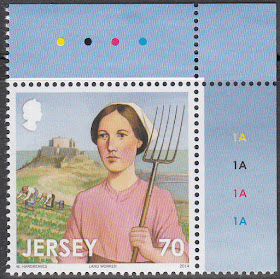As Christmas present I got this year some online ordered stamps. Among them are stamps from Guernsey and Jersey about the World War I Centenary.
The first set I got was issued on 4th August 2014 by Jersey Post and deals with Jersey's participation in the Great War. Jersey was affected by the war just like all other communities in Britain. 6000 soldiers left Jersey during the war to fight for their homeland. The six stamps show different groups from Jersey and their role during the war set against different places on Jersey.
The first stamp shows a member of the Royal Jersey Militia. The Royal Jersey Militia was the local militia of Jersey. The Channel Islands were then the only part of the British Empire with an own existing militia. It was mobilised on 30th July 1914.
The Voluntary Aid Detachment (VAD), as shown on the second stamp, was a voluntary unit providing field nursing services. It was founded in 1909 and played an important role during the World Wars. Many of its members were women and girls and thus it helped to change the role of women in society. At the beginning of World War I the VADs were not accepted by the military authorities, but after they proved their use and because of a shortage of trained nurses, they became a crucial part in military hospitals. During the war their skills increased and they became an invaluable source of bedside aid.
At the beginning of World War I 11% of Jersey's population were of French origin. The French men of soldiering age were held in reserve, but many also left Jersey to fight "Pour La Patrie".
As most of the men were gone, the women had to become agricultural workers to maintain Jersey's crops and cattle.
The 82p stamp shows a boy selling flags. By the use of selling small silk flags money was raised for the war. The people buying the flags had thus an easy way to show support for the troops.
Because Jersey is an island, the Jerseymen had a strong maritime connection, due to which many of them joined the Marine.
The appertaining souvenir sheet shows the poster "Are YOU in this?". It was created by Lt General Robert Baden-Powell and was published by the Parliamentary Recruiting Committee around 1915. It shows how all members of the society take part in the war.
The second set of Jersey stamps was issued on 4th August 2015 and focuses on change. During World War I various changes were needed to achieve the upper hand. The stamps include the development of mechanisation, communication, camouflage and deception, uniform, observation and the tactics of war.
The appertaining souvenir sheet shows Flt Lt Charles Stanley Mossop DSC from Jersey. He was the first man to sink a submarine from the air. In August 1918 he also became the first Jerseyman to land an airplane on the island, when I visited his parents in Jersey's capital Saint Helier while he was on an aerial photo-reconnaissance mission. He was killed two days later in a flying accident in France.
The stamps from Guernsey focus on the role of the post office during World War I. The post office helped to keep in touch with the family members having left the Bailiwick of Guernsey to fight abroad. But the post office also lost many of its workers, as they wanted to fight abroad, 43 workers of the Guernsey Post Office did so. After the war many former soldiers worked for the post office, because its sense of duty, its structure and its solidarity reflected their time in the armed forces.
The 62p stamp from the set shows the Post Office Rifles. The Post Office Rifles was founded in 1868 from members of the General Post Office. During World War I it fought at the Western Front.
The others stamps show Sark's Postman Private Philip Carré, the Mailboat SS Vera, a Christmas card sent by Lieutenant Peter Le Page, a Field Service Post Card sent by Private Yves Cataroche and Robert and Ethel Bynam.




















No comments:
Post a Comment